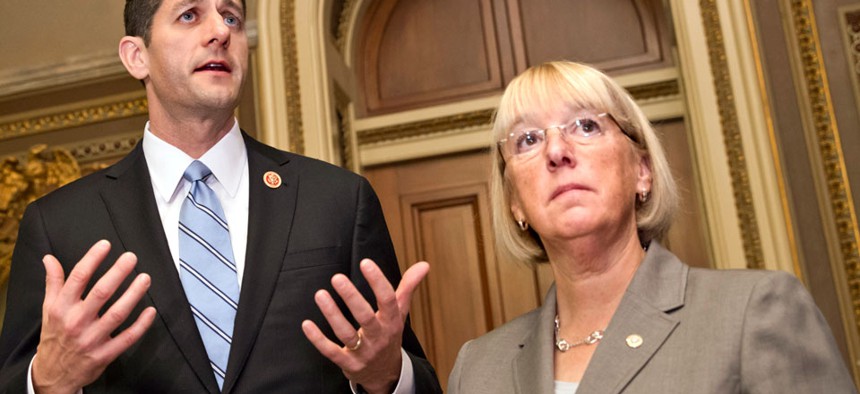
Paul Ryan, R-Wis., and Patty Murray, D-Wash. J. Scott Applewhite/AP
Chasm Between Competing Budget Plans Will Be Difficult to Bridge
A 'grand bargain' appears unlikely as conferees head into their first meeting this week.
Expectations are low from both Republicans and Democrats as their House and Senate budget conferees prepare to sit down for their first formal meeting Wednesday, with the prospects of any "grand bargain" on 10-year deficit-reduction goals being roundly dismissed.
Rather, the anticipation about any agreement emerging—if there is one at all—is that it will have a much narrower focus, addressing only the rest of the current fiscal year that lasts through Sept. 30, 2014, or perhaps an even shorter period. Some relief might be thrown in by rejiggering the automatic spending cuts under sequestration in some way, and by closing a few tax loopholes.
Will the conference be a missed opportunity? Some lawmakers, senior aides, and outside experts say it could be a chance for the 29 conferees led by the two Budget Committee chairs—Sen. Patty Murray, D-Wash., and Rep. Paul Ryan, R-Wis.—to debate out in the open the larger public-policy effects of their approaches, and then work on a cohesive multiyear budget plan.
Even though such a breakthrough is seen as unlikely, the talks begin with some clear starting points—the budget blueprints passed by each chamber earlier this year.
OVERALL
- Ryan's House budget plan is billed as balancing the budget in 10 years by cutting spending $5.7 trillion, compared with the Congressional Budget Office's baseline ($4.6 trillion if there is an assumption that war costs will be reduced, a baseline Ryan uses).
- Murray's Senate bill seeks a combination of new revenue and spending cuts to reduce the deficit by about $1.85 trillion over 10 years. If a proposed jobs and infrastructure package is not included, the amount of savings in the Senate plan would go from $1.85 trillion to about $1.95 trillion over 10 years.
REVENUE AND TAX REFORM
- The House budget proposal calls for revenue-neutral tax reforms relative to the CBO baseline, such as repealing the alternative minimum tax and reducing the corporate tax rate.
- About half of the Senate's planned deficit reduction over 10 years—$975 billion—would come from new revenues, mostly from corporations and wealthy households.
DISCRETIONARY SPENDING
- The House budget includes $966 billion in discretionary spending for fiscal 2014, divided between $552 billion in defense and $414 billion in nondefense spending.
- The Senate budget includes a topline of $1.058 trillion in discretionary spending for fiscal 2014, divided between $552 billion in defense and $506 billion in nondefense spending.
SEQUESTRATION
- The House budget exceeds the defense sequestration cap set in the 2011 Budget Control Act by about $54 billion for fiscal 2014. But it cuts nondefense discretionary by an equivalent amount, in a move to transfer the defense sequester to domestic programs and maintain some of the overall cap.
- The Senate budget exceeds the sequestration caps by $91 billion for fiscal 2014, but calls for replacing the sequester cuts with a combination of new revenue and spending—and doing so fully over 10 years.
MEDICARE AND MEDICAID
- The House budget would change Medicaid to a block grant for states; Medicare would be converted to allocations to beneficiaries based on their income, and the amounts could be used for private insurance or a form of traditional Medicare. Those changes would start in 2024 and would affect those who are currently 55 or younger. The House plan would also increase the eligibility age for Medicare from 65 to 67 by 2035.
- The Senate plan includes a $265 billion reduction to Medicare and a $10 billion cut to Medicaid, without making major structural changes.
AFFORDABLE CARE ACT
- The House budget would repeal most of the health care law, including its exchange subsidies and Medicaid expansion.
- The Senate budget assumes full implementation of the Affordable Care Act.
DEFICIT AND DEBT
- The House projects that its budget would deliver a $7 billion surplus by 2023, based on CBO baselines. The debt would stabilize in 2015 at 74.1 percent of gross domestic product, then decline each year to 54.8 percent of GDP in 2023.
- The Senate projects a $566 billion deficit by 2023. Debt would stabilize in 2015 at 77.1 percent of GDP, then decline each year to 70.4 percent of GDP in 2023.
- The budget conference has until about Dec. 13 to come up with a government spending plan that can pass both chambers. Time is so short because the legislation that reopened the government expires Jan. 15, and another shutdown looms unless a new agreement can be negotiated by then.







